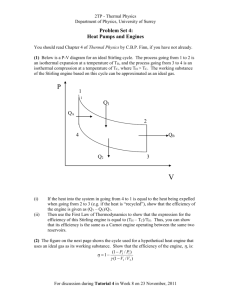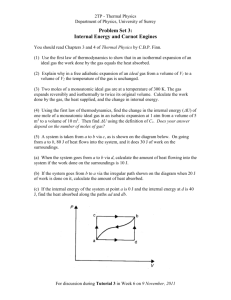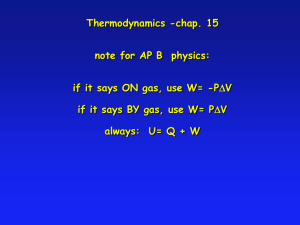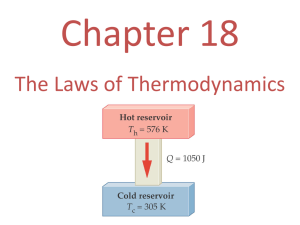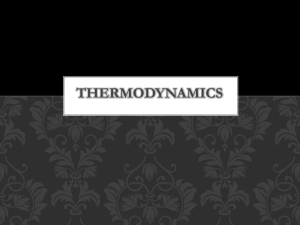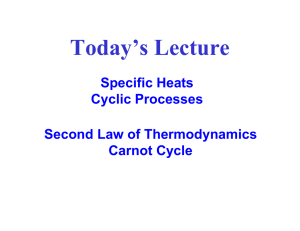Thermodynamics
advertisement
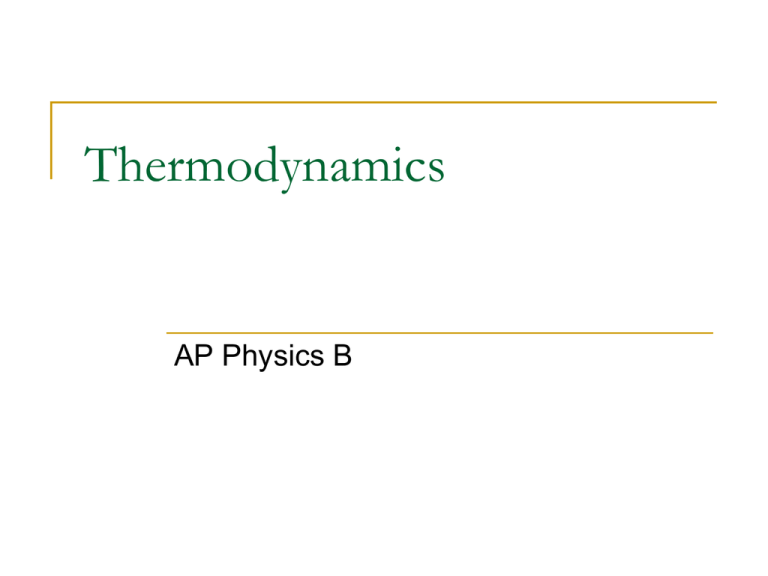
Thermodynamics AP Physics B Work done by a gas Suppose you had a piston filled with a specific amount of gas. As you add heat, the temperature rises and thus the volume of the gas expands. The gas then applies a force on the piston wall pushing it a specific displacement. Thus it can be said that a gas can do WORK. Work is the AREA of a P vs. V graph W PV V Work is done BY the gas V Work is done ON the gas Wby negative Won positive The “negative” sign in the equation for WORK is often misunderstood. Since work done BY a gas has a positive volume change we must understand that the gas itself is USING UP ENERGY or in other words, it is losing energy, thus the negative sign. When work is done ON a gas the change in volume is negative. This cancels out the negative sign in the equation. This makes sense as some EXTERNAL agent is ADDING energy to the gas. Internal Energy (U) and Heat Energy (Q) All of the energy inside a system is called INTERNAL ENERGY, U. When you add HEAT(Q), you are adding energy and the internal energy INCREASES. U T Both are measured in joules. But when you add heat, there is usually an increase in temperature associated with the change. if T , U if T 0, U 0 First Law of Thermodynamics “The internal energy of a system tend to increase when HEAT is added and work is done ON the system.” Suggests a CHANGE or subtraction U Q W U QAdd Won or U QAdd Wby You are really adding a negative here! The bottom line is that if you ADD heat then transfer work TO the gas, the internal energy must obviously go up as you have MORE than what you started with. Example Sketch a PV diagram and find the work done by the gas during the following stages. (a) A gas is expanded from a volume of 1.0 L to 3.0 L at a constant pressure of 3.0 atm. WBY PV 3x105 (0.003 0.001) 600 J (b) The gas is then cooled at a constant volume until the pressure falls to 2.0 atm W PV 0 since V 0 Example continued a) The gas is then compressed at a constant pressure of 2.0 atm from a volume of 3.0 L to 1.0 L. WON PV 2 x105 (.001 .003) -400 J b) The gas is then heated until its pressure increases from 2.0 atm to 3.0 atm at a constant volume. W PV 0 since V 0 Example continued What is the NET WORK? 600 J + -400 J = 200 J Rule of thumb: If the system rotates CW, the NET work is positive. If the system rotates CCW, the NET work is negative. NET work is the area inside the shape. Example A series of thermodynamic processes is shown in the pV-diagram. In process ab 150 J of heat is added to the system, and in process bd , 600J of heat is added. Fill in the chart. 150 0 150 J 600 240 840 J 750 240 990 J 90 0 900 90 990 J Thermodynamic Processes - Isothermal To keep the temperature constant both the pressure and volume change to compensate. (Volume goes up, pressure goes down) “BOYLES’ LAW” Thermodynamic Processes - Isobaric Heat is added to the gas which increases the Internal Energy (U) Work is done by the gas as it changes in volume. The path of an isobaric process is a horizontal line called an isobar. ∆U = Q - W can be used since the WORK is POSITIVE in this case Thermodynamic Processes - Isovolumetric Thermodynamic Processes - Adiabatic ADIABATIC- (GREEKadiabatos"impassable") In other words, NO HEAT can leave or enter the system. In Summary Second Law of Thermodynamics “Heat will not flow spontaneously from a colder body to a warmer body AND heat energy cannot be transformed completely into mechanical work.” The bottom line: 1) Heat always flows from a hot body to a cold body 2) Nothing is 100% efficient Engines Heat flows from a HOT reservoir to a COLD reservoir QH W QC Woutput QH QC QH = remove from, absorbs = hot QC= exhausts to, expels = cold Engine Efficiency In order to determine the thermal efficiency of an engine you have to look at how much ENERGY you get OUT based on how much you energy you take IN. In other words: QH QC QC W ethermal 1 Qhot QH QH Rates of Energy Usage Sometimes it is useful to express the energy usage of an engine as a RATE. For example: The RATE at which heat is absorbed! The RATE at which heat is expelled. QH t QC t The RATE at which WORK is DONE W POWER t Efficiency in terms of rates W W P t ethermal QH QH QH t t QH P t e QH QC P t t Is there an IDEAL engine model? Our goal is to figure out just how efficient such a heat engine can be: what’s the most work we can possibly get for a given amount of fuel? The efficiency question was first posed—and solved—by Sadi Carnot in 1820, not long after steam engines had become efficient enough to begin replacing water wheels, at that time the main power sources for industry. Not surprisingly, perhaps, Carnot visualized the heat engine as a kind of water wheel in which heat (the “fluid”) dropped from a high temperature to a low temperature, losing “potential energy” which the engine turned into work done, just like a water wheel. Carnot Efficiency Carnot a believed that there was an absolute zero of temperature, from which he figured out that on being cooled to absolute zero, the fluid would give up all its heat energy. Therefore, if it falls only half way to absolute zero from its beginning temperature, it will give up half its heat, and an engine taking in heat at T and shedding it at ½T will be utilizing half the possible heat, and be 50% efficient. Picture a water wheel that takes in water at the top of a waterfall, but lets it out halfway down. So, the efficiency of an ideal engine operating between two temperatures will be equal to the fraction of the temperature drop towards absolute zero that the heat undergoes. Carnot Efficiency Carnot temperatures must be expressed in KELVIN!!!!!! The Carnot model has 4 parts •An Isothermal Expansion •An Adiabatic Expansion •An Isothermal Compression •An Adiabatic Compression The PV diagram in a way shows us that the ratio of the heats are symbolic to the ratio of the 2 temperatures Example A particular engine has a power output of 5000 W and an efficiency of 25%. If the engine expels 8000 J of heat in each cycle, find (a) the heat absorbed in each cycle and (b) the time for each cycle P 5000W e 0.25 Qc 8000 J QC e 1 QH 0.25 1 QH 8000 QH 10,667 J W QH QC W QH 8000 W P 2667 J W W 5000 t t t 0.53 s Example The efficiency of a Carnot engine is 30%. The engine absorbs 800 J of heat per cycle from a hot temperature reservoir at 500 K. Determine (a) the heat expelled per cycle and (b) the temperature of the cold reservoir W W e 0.30 QH 800 J W W QH QC W 800 QC QC 560 J TC TC eC 1 0.30 1 TH 500 TC 350 K 240 J




